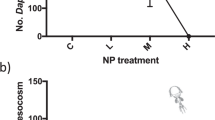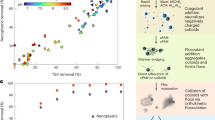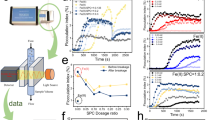Abstract
Aqueous concentrations of nanoplastics are critical for their risk assessment. Here we developed an optical manipulation and surface-enhanced Raman scattering set-up to capture, enrich and detect nanoplastics in aquatic environments. A small-sized (20 µm) gold nanoparticle stack was used to design a gold nanoparticle stack/polylactic acid optical tweezer, and individual nanoplastics were precisely manipulated. A large-sized (80 µm) gold nanoparticle stack enabled massive enrichment of nanoplastics, and high enrichment recoveries (for example, 89.3–94.3% for polystyrene) and low limits of detection (for example, 150 ng l−1 for polystyrene) of nanoplastics were achieved. Moreover, interference from natural organic matter was eliminated by adding a cleaning step before detection. The nanoplastics in natural waters (required volume, ≤7.2 ml) were thus successfully enriched and analysed, with determined concentrations of polystyrene nanoplastics of 6.5–8.5, 1.4–1.8 and 0.7–1.0 μg l−1 for water samples from a river, a mariculture farm and a beach, respectively. This newly developed optical manipulation–surface-enhanced Raman scattering approach is able to simultaneously enrich and detect nanoplastics in natural waters.
This is a preview of subscription content, access via your institution
Access options
Subscribe to this journal
Receive 12 digital issues and online access to articles
118,99 € per year
only 9,92 € per issue
Buy this article
- Purchase on SpringerLink
- Instant access to full article PDF
Prices may be subject to local taxes which are calculated during checkout






Similar content being viewed by others
Data availability
The raw data that support the findings of this study are available via Figshare at https://doi.org/10.6084/m9.figshare.28104761 (ref. 34). Source data are provided with this paper.
References
Allen, D. et al. Microplastics and nanoplastics in the marine-atmosphere environment. Nat. Rev. Earth Environ. 3, 393–405 (2022).
Zhao, J. et al. Microplastic fragmentation by rotifers in aquatic ecosystems contributes to global nanoplastic pollution. Nat. Nanotechnol. 19, 406–414 (2024).
Langenfeld, D. et al. Microplastics at environmentally relevant concentrations had minimal impacts on pelagic zooplankton communities in a large in-lake mesocosm experiment. Environ. Sci. Technol. 58, 19419–19428 (2024).
Wang, M. et al. Oligomer nanoparticle release from polylactic acid plastics catalysed by gut enzymes triggers acute inflammation. Nat. Nanotechnol. 18, 403–411 (2023).
Xue, R. et al. Mechanistic understanding toward the maternal transfer of nanoplastics in Daphnia magna. ACS Nano. 17, 13488–13499 (2023).
Jeong, B. et al. Maternal exposure to polystyrene nanoplastics causes brain abnormalities in progeny. J. Hazard. Mater. 426, 127815 (2022).
Ragusa, A. et al. Plasticenta: first evidence of microplastics in human placenta. Environ. Int. 146, 106274 (2021).
Shi, C. et al. Emergence of nanoplastics in the aquatic environment and possible impacts on aquatic organisms. Sci. Total Environ. 906, 167404 (2024).
Li, Q. et al. Spatial distribution of polystyrene nanoplastics and small microplastics in the Bohai Sea, China. Sci. Total Environ. 881, 163222 (2023).
Xu, Y., Ou, Q., Jiao, M., Liu, G. & van der Hoek, J. P. Identification and quantification of nanoplastics in surface water and groundwater by pyrolysis gas chromatography−mass spectrometry. Environ. Sci. Technol. 56, 4988–4997 (2022).
Qian, N. et al. Rapid single-particle chemical imaging of nanoplastics by SRS microscopy. Proc. Natl Acad. Sci. USA 121, e2300582121 (2024).
Moon, S. et al. Direct observation and identification of nanoplastics in ocean water. Sci. Adv. 10, eadh1675 (2024).
Hu, M., Petrova, H. & Hartland, G. V. Investigation of the properties of gold nanoparticles in aqueous solution at extremely high lattice temperatures. Chem. Phys. Lett. 391, 220–225 (2004).
Xie, L., Gong, K., Liu, Y. & Zhang, L. Strategies and challenges of identifying nanoplastics in environment by surface-enhanced Raman spectroscopy. Environ. Sci. Technol. 57, 25–43 (2023).
Fang, C. et al. Identification and visualisation of microplastics/nanoplastics by Raman imaging (iii): algorithm to cross-check multi-images. Water Res. 194, 116913 (2021).
Ashkin, A. Forces of a single-beam gradient laser trap on a dielectric sphere in the ray optics regime. Biophys. J. 61, 569–582 (1992).
Yamanishi, J. et al. Optical gradient force on chiral particles. Sci. Adv. 8, eabq2604 (2022).
Xin, K. et al. Method of optical manipulation of gold nanoparticles for surface-enhanced Raman scattering in a microcavity. Opt. Express 28, 8734–8743 (2020).
Braun, D. & Libchaber, A. Trapping of DNA by thermophoretic depletion and convection. Phys. Rev. Lett. 89, 188103 (2002).
Xu, J., Zhang, J., Wang, H. & Mi, J. Fine particle behavior in the air flow past a triangular cylinder. Aerosol Sci. Technol. 47, 875–884 (2013).
Lei, H., Zhang, Y. & Li, B. Particle separation in fluidic flow by optical fiber. Opt. Express 20, 1292–1300 (2012).
Maity, S., Bochinski, J. R. & Clarke, L. I. Metal nanoparticles acting as light-activated heating elements within composite materials. Adv. Funct. Mater. 22, 5259–5270 (2012).
Zhang, S. et al. A numerical model for water hydration on nanosurfaces: from friction to hydrophilicity and hydrophobicity. Phys. Chem. Chem. Phys. 25, 19788 (2023).
McNab, G. S. & Meisen, A. Thermophoresis in liquids. J. Colloid Interface Sci. 44, 339–346 (1973).
Leake, D. K. et al. Optical particle sorting on an optofluidic chip. Opt. Express 21, 32605–32610 (2013).
Soong, C. Y., Li, W. K., Liu, C. H. & Tzeng, P. Y. Theoretical analysis for photophoresis of a microscale hydrophobic particle in liquids. Opt. Express 18, 2168–2182 (2010).
Xiao, S. et al. Fast and portable fluorescence lifetime analysis for early warning detection of micro- and nanoplastics in water. Environ. Res. 244, 117936 (2024).
Zhang, J. et al. Identification of poly(ethylene terephthalate) nanoplastics in commercially bottled drinking water using surface-enhanced Raman spectroscopy. Environ. Sci. Technol. 57, 8365–8372 (2023).
Liu, Q. et al. Analysis of humus in seawater and sediments in Changjiang Estuary. Mar. Environ. Sci. 25, 13–16 (2006).
Li, P. et al. Total organic carbon as a quantitative index of micro- and nano-plastic pollution. Anal. Chem. 94, 740–747 (2022).
Frens, G. & Kolloid, Z. Controlled nucleation for the regulation of the particle size in monodisperse gold suspensions. Nat. Phys. Sci. 241, 20–22 (1973).
Ramachandran, S., Sobhan, C. B. & Peterson, G. P. Thermophoresis of nanoparticles in liquids. Int. J. Heat Mass Transfer 147, 118925 (2020).
Zhao, J., Wang, Z., Ghosh, S. & Xing, B. Phenanthrene binding by humic acid-protein complexes as studied by passive dosing technique. Environ. Pollut. 184, 145–153 (2014).
Shi, X et al. Simulation and spectral data related to OM-SERS. figshare https://doi.org/10.6084/m9.figshare.28104761 (2025).
Acknowledgements
This work was funded by Laoshan Laboratory (grant no. LSKJ202203901), the National Natural Science Foundation of China (grant nos. 42206191, 42192572 and U2106213), the Shandong Provincial Natural Science Foundation (grant no. ZR2020MF121), Shandong Provincial Natural Science Foundation Youth Project (grant no. ZR2021QF047), Taishan Scholars Program of Shandong Province (grant no. tsqn201909051) and the USDA Hatch Program (grant no. MAS 00616).
Author information
Authors and Affiliations
Contributions
X.S., T.M., X.H. and H.S. contributed equally to this work. Conceptualization: H.Z., J.M., J.Z. and B.X.; methodology: X.S., X.H., T.M., H.S. and K.J.; investigation: X.S., X.H., T.M. and H.S.; visualization: X.S., X.H., T.M., H.S. and R.L.; supervision: X.S., J.Z. and B.X.; writing—original draft: X.S., T.M. and H.S.; writing—review and editing: J.Z. and B.X.
Corresponding authors
Ethics declarations
Competing interests
The authors declare no competing interests.
Peer review
Peer review information
Nature Water thanks Jingjing Du, Liwu Zhang and the other, anonymous, reviewer(s) for their contribution to the peer review of this work.
Additional information
Publisher’s note Springer Nature remains neutral with regard to jurisdictional claims in published maps and institutional affiliations.
Supplementary information
Supplementary Information
Supplementary Figs. 1–20, Videos 1–6 and Tables 1–6.
Supplementary Video 1
Rapid manipulation of PS nanoplastics by a GNS (80 μm) with the assistance of the fluid drag force.
Supplementary Video 2
The specific process for the precise manipulation of nanoplastics.
Supplementary Video 3
Capturing a PS nanofibre from a nanoplastics mixture.
Supplementary Video 4
Re-suspension of enriched nanoplastics into the fluid when the laser was turned off.
Supplementary Video 5
The enrichment of nanoplastics from the river water sampled from Licun River (Qingdao, China).
Supplementary Video 6
The flow of nanoplastics through the microchannel.
Supplementary Data 1
Source data for supplementary figures.
Source data
Source Data Fig. 1
Statistical source data.
Source Data Fig. 2
Statistical source data.
Source Data Fig. 3
Statistical source data.
Source Data Fig. 4
Statistical source data.
Source Data Fig. 5
Statistical source data.
Source Data Fig. 6
Statistical source data.
Rights and permissions
Springer Nature or its licensor (e.g. a society or other partner) holds exclusive rights to this article under a publishing agreement with the author(s) or other rightsholder(s); author self-archiving of the accepted manuscript version of this article is solely governed by the terms of such publishing agreement and applicable law.
About this article
Cite this article
Shi, X., Mao, T., Huang, X. et al. Capturing, enriching and detecting nanoplastics in water based on optical manipulation, surface-enhanced Raman scattering and microfluidics. Nat Water 3, 449–460 (2025). https://doi.org/10.1038/s44221-025-00417-8
Received:
Accepted:
Published:
Issue Date:
DOI: https://doi.org/10.1038/s44221-025-00417-8



